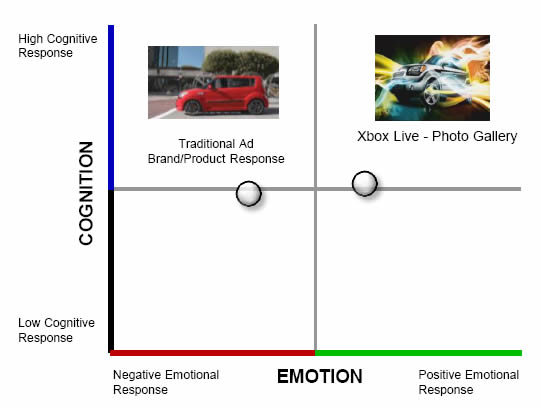Neuromarketing at Microsoft

Video games and movies are one of the more interesting neuromarketing applications, in that the technology can be applied to not just advertising but the product itself. A new effort by Microsoft and Emsense carries that idea one step further by attempting to compare viewer engagement with advertising across multiple technology platforms, including Xbox LIVE and traditional television spots.
The Xbox LIVE campaigns consisted of interactive billboards that users could click through to a branded landing page where they could then interact with content and download videos. The traditional videos used in this study included a 30-second television spot for Hyundai and a 60-second in-theater spot for Kia Motors America.
The results showed more time spent, greater recall and higher levels of emotional and cognitive response in association with the Xbox LIVE ad campaigns than with the traditional video spots. The interactive capabilities of Xbox LIVE enabled an additional 238 seconds of engagement beyond the traditional video ad, which lead to increased unaided recall and brand awareness. For example, the Xbox LIVE ads delivered 90 percent unaided brand recall, compared with 78 percent unaided brand recall rates for the 60-second spot. In addition, the Xbox LIVE ads delivered higher levels of both cognitive and emotional responses.
[From press release – Microsoft and Mediabrands Unveil Groundbreaking Research.]
The study claims that Xbox LIVE ads engage viewer on both emotional and cognitive levels:

While we aren’t shocked to learn that Microsoft’s ad medium outperformed the competition in their own study, that doesn’t mean the work is without merit. This is likely the first effort which applies both conventional and neuromarketing techniques to evaluate the effectiveness of advertising in very different media.
No EEGs or fMRIs were used in the study. Rather, a headband was worn by the subjects and their brain activity, breathing rate, head motion, heart rate, blink rate, and skin temperature, were recorded during exposure to the media.
The study is a joint effort of Microsoft and Mediabrands. Details can be read in the downloadable white paper, Cracking the Code on Cross-Media Engagement.
